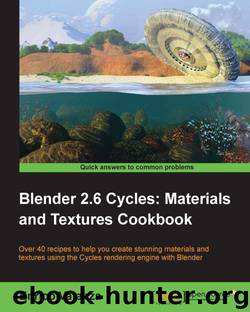Blender 2.6 Cycles: Materials and Textures Cookbook by Blender 2 6 Cycles Materials & Textures Cookbook 2013

Author:Blender 2 6 Cycles Materials & Textures Cookbook 2013
Language: eng
Format: epub
Publisher: Packt Publishing
Add a Voronoi Texture node (press Shift + A and go to Texture | Voronoi Texture) and a Wave Texture node (press Shift + A and go to Texture | Wave Texture). Press Shift + D to duplicate the Voronoi Texture node and move it right under the first one. In the first Voronoi node set Coloring to Cells and Scale to 20.000; in the second one set Scale to 19.000. Set the Wave Texture node's Scale to 1.000.
Connect the Vector output of the Mapping node to the Vector inputs of the three texture nodes.
Add a Mix node (press Shift + A and go to Color | Mix), set the Blend Type to Difference and the Fac value to 1.000, then connect the first Voronoi node's Color output to the Color1 input socket and the second Voronoi node's Color output to the Color2 input socket of the Difference node.
Press Shift + D to duplicate the Difference node and connect the Color output of the first one to the Color1 input socket of this duplicated one, then connect the Color output of the Musgrave Texture node to the Color2 input socket.
Add a ColorRamp node (press Shift + A and go to Convertor | ColorRamp) and connect the output of the second Difference node to its Fac input socket. Set the ColorRamp interpolation to Ease and move the black color marker to the middle of the slider.
Press Shift + D to duplicate the ColorRamp node, set the interpolation to B-Spline and move back the black color marker to one-third along the total length of the slider. Connect the second Difference node's Color output to the Fac input of this ColorRamp too.
Press Shift + D to duplicate a Difference node and move it after the ColorRamp nodes; connect the two ColorRamp node's Color outputs to the Color1 and Color2 inputs of the last Difference node.
Add a frame (press Shift + A and go to Layout | Frame), select these last nodes and then the frame itself and press Ctrl + P to parent them. Rename the frame RUST_BUMP.
Inside the SHADERS frame, add a Bump node (press Shift + A and go to Vector | Bump). Connect the RUST_BUMP frame's final Difference node's Color output to the Bump node's Height input socket, and its Normal output to the Normal input socket of the Diffuse shader inside the SHADERS frame.
Download
This site does not store any files on its server. We only index and link to content provided by other sites. Please contact the content providers to delete copyright contents if any and email us, we'll remove relevant links or contents immediately.
Sass and Compass in Action by Wynn Netherland Nathan Weizenbaum Chris Eppstein Brandon Mathis(7969)
Supercharging Productivity with Trello by Brittany Joiner(7331)
Mastering Tableau 2023 - Fourth Edition by Marleen Meier(7103)
Inkscape by Example by István Szép(6973)
Secrets of the JavaScript Ninja by John Resig Bear Bibeault(6739)
Visualize Complex Processes with Microsoft Visio by David J Parker & Šenaj Lelić(6656)
Build Stunning Real-time VFX with Unreal Engine 5 by Hrishikesh Andurlekar(5683)
Design Made Easy with Inkscape by Christopher Rogers(5003)
Customizing Microsoft Teams by Gopi Kondameda(4544)
Business Intelligence Career Master Plan by Eduardo Chavez & Danny Moncada(4445)
Extending Microsoft Power Apps with Power Apps Component Framework by Danish Naglekar(4155)
Salesforce Platform Enterprise Architecture - Fourth Edition by Andrew Fawcett(4018)
Linux Device Driver Development Cookbook by Rodolfo Giometti(4010)
Pandas Cookbook by Theodore Petrou(4009)
The Tableau Workshop by Sumit Gupta Sylvester Pinto Shweta Sankhe-Savale JC Gillet and Kenneth Michael Cherven(3821)
Exploring Microsoft Excel's Hidden Treasures by David Ringstrom(3295)
TCP IP by Todd Lammle(3120)
Applied Predictive Modeling by Max Kuhn & Kjell Johnson(3006)
Drawing Shortcuts: Developing Quick Drawing Skills Using Today's Technology by Leggitt Jim(2978)
